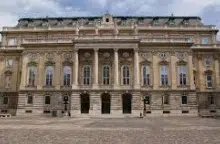The first step we are going to take before fully entering into the meaning of the term Neoclassicism is to know its etymological origin. In this case, it must be established that it derives from both Greek and Latin and that it is the result of the sum of the following lexical components:
-The Greek word “neos”, which can be translated as “new”.
-The Latin word “classicus”, which is synonymous with “classic”.
-The suffix “-ism”, which is equivalent to “doctrine” and “movement”.
Neoclassicism is an artistic movement born in the 18th century that imitates the predominant style and characteristics of classical antiquity . It is an aesthetic that sought to move away from the excesses of the baroque to return to the ancient pillars.
 In this way, framed in the context of the Enlightenment , Neoclassicism promoted a return to reason and the artistic manifestations of Greco-Roman antiquity as a guide. In the field of sculpture , for example, he opted for pure lines and the use of white marble.
In this way, framed in the context of the Enlightenment , Neoclassicism promoted a return to reason and the artistic manifestations of Greco-Roman antiquity as a guide. In the field of sculpture , for example, he opted for pure lines and the use of white marble.
On the architectural level, Neoclassicism developed monumental and functional buildings such as theaters , museums and hospitals. Neoclassical architects sought to find a universally valid architectural model.
Neoclassical painting, meanwhile, recovered Roman myths . Predominance was given to form and drawing , leaving color in the background.
In the same way, it should be noted that Neoclassicism in art also opted for its works to have a didactic and even moralizing character, because they maintained a clear balance, because they transmitted values such as freedom and because they addressed politics in many cases.
Among the most important works of Neoclassicism are some such as these:
-The painting of “The Family of Charles IV” (1880) by Francisco de Goya.
-The painting “The Death of Marat” (1793) by Jacques-Louis David.
-The sculptural work “The Three Graces” (1817) by Antonio Canova.
-On an architectural level, the Pantheon of Paris (1758), made by Jacques-Germain Soufflot.
It should be noted that, in the context of the rise of Neoclassicism , numerous archaeological expeditions were carried out to find and rescue works from classical antiquity . In line with this idea, Rome regained its importance as the cultural capital of Western society and that is why neoclassical artists used to travel to visit it.
If we talk about literary Neoclassicism, we have to establish that it featured artists such as Daniel Defoe, creator of “Robinson Crusoe” (1719), or Jonathan Swift, the author of “Gulliver's Travels” (1726).
In the musical field, within that aforementioned movement we can highlight the existence of figures of the stature of Antonio Salieri, Ludwig van Beethoven or Wolfang Amadeus Mozart.
At a general level, it can be said that Neoclassicism marked a return to simplicity . Mythology and history once again became the most important themes when it came to artistic creation. The superfluity and complexity of baroque and rococo were left behind and simplicity, balance and clarity were advocated.
